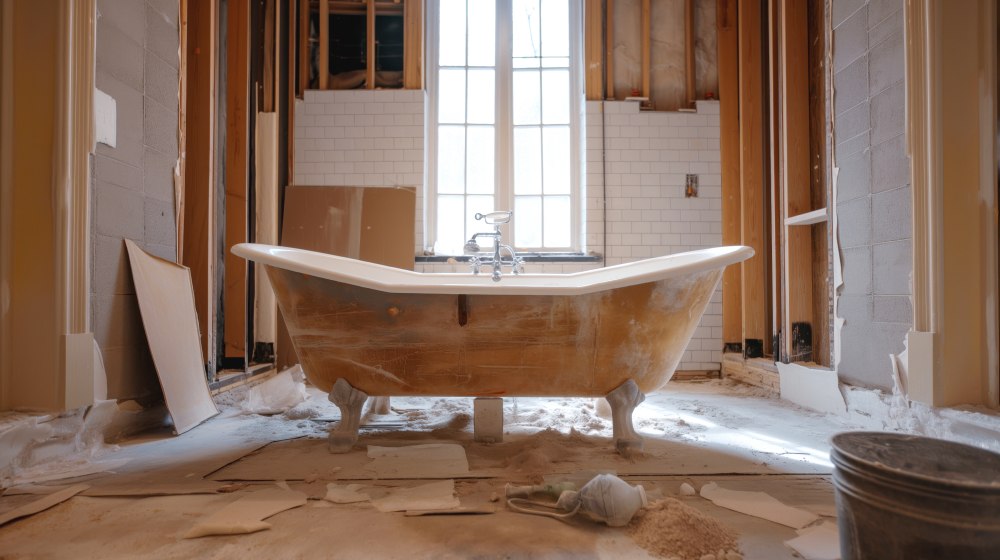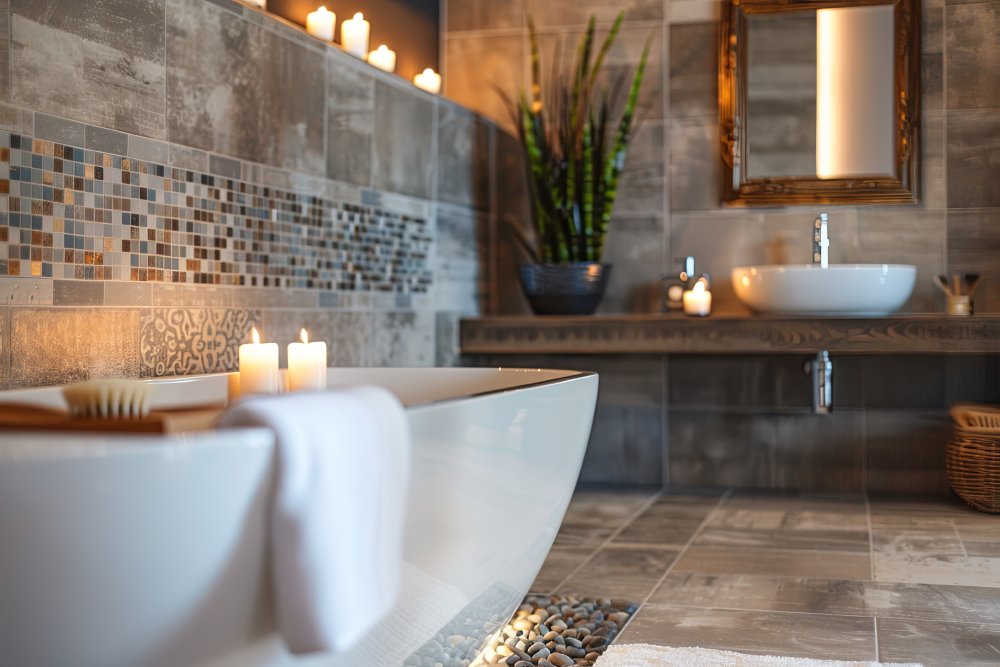1. Install Non-Slip Flooring
Overview:Slippery floors are a common cause of falls in the bathroom. Choosing the right flooring and adding non-slip surfaces can significantly reduce the risk of accidents.
Steps:- Choose Non-Slip Flooring: Opt for non-slip tiles, vinyl, or rubber flooring that provides better traction even when wet.
- Add Non-Slip Mats: Place non-slip mats or rugs with rubber backing in front of the sink, toilet, and bathtub/shower to prevent slips.
- Use Non-Slip Coatings: Apply non-slip coatings or treatments to existing tile or stone floors to increase traction.
- Secure Mats: Ensure that all mats and rugs are securely fastened to the floor to prevent them from sliding.
- Regular Cleaning: Keep floors clean and dry to avoid the buildup of soap scum or mold, which can make surfaces slippery.
2. Install Grab Bars and Handrails
Overview:Grab bars and handrails provide support and stability, especially for seniors and individuals with mobility issues. They are essential safety features in any bathroom.
Steps:- Choose the Right Locations: Install grab bars near the toilet, in the shower or bathtub, and along walls where extra support is needed.
- Select Sturdy Materials: Use stainless steel or other strong, rust-resistant materials for grab bars.
- Proper Installation: Ensure grab bars are securely anchored into wall studs to support weight effectively.
- Textured Bars: Choose grab bars with a textured surface for a better grip.
- Multiple Heights: Install bars at various heights to accommodate all users.
3. Ensure Proper Lighting
Overview:Good lighting is crucial for preventing accidents and ensuring visibility in the bathroom. Adequate lighting can help family members, especially seniors, navigate the space safely.
Steps:- Install Bright Overhead Lighting: Use bright, evenly distributed lighting to eliminate dark spots and shadows.
- Add Task Lighting: Install task lighting around the mirror and vanity for activities like shaving, makeup application, and grooming.
- Night Lights: Use night lights or motion-sensor lights to provide illumination during nighttime trips to the bathroom.
- Warm Light: Use warm, soft lighting to reduce glare and eye strain.
- Regular Maintenance: Replace burned-out bulbs promptly to maintain adequate lighting levels.
Join HICP Homeowner’s Alliance
Connect with experts, get special discounts and enjoy member benefits
4. Use Temperature-Control Devices
Overview:Scalding water is a common hazard in bathrooms. Installing temperature-control devices can prevent accidental burns and ensure safe water temperatures.
Steps:- Anti-Scald Devices: Install anti-scald devices or thermostatic mixing valves on faucets and showerheads to regulate water temperature.
- Adjust Water Heater: Set the water heater thermostat to a safe temperature (typically 120°F or 49°C) to prevent scalding.
- Check Temperatures: Regularly check water temperatures to ensure they remain within safe limits.
- Test Water: Always test the water temperature before entering the bath or shower, especially for children and seniors.
- Label Controls: Clearly label hot and cold water controls for easy identification.
5. Ensure Safe Bathing Solutions
Overview:Bathing can be a challenging and risky activity for young children and seniors. Implementing safe bathing solutions can make the process safer and more comfortable.
Steps:- Install a Walk-In Tub: Consider installing a walk-in bathtub that provides easy access and reduces the risk of slipping and falling.
- Use Shower Chairs: Use a sturdy shower chair or bench to provide a safe seating option for those who need it.
- Handheld Showerheads: Install handheld showerheads to allow for better control and flexibility during bathing.
- Non-Slip Surfaces: Ensure that the bottom of the bathtub or shower is equipped with non-slip strips or mats.
- Assistive Devices: Use bath lifts or transfer benches to assist seniors or individuals with mobility issues in getting in and out of the tub safely.
6. Childproofing Measures
Overview:Bathrooms can be particularly hazardous for young children. Childproofing measures can help prevent accidents and keep children safe.
Steps:- Lock Cabinets: Use childproof locks on cabinets and drawers to keep dangerous items like cleaning supplies, medications, and sharp objects out of reach.
- Cover Outlets: Install outlet covers to prevent children from inserting objects into electrical outlets.
- Toilet Locks: Use toilet locks to prevent young children from playing in or around the toilet.
- Supervision: Always supervise young children in the bathroom to prevent accidents.
- Safe Storage: Store personal care products, medications, and cleaning supplies in high, secure locations.
7. Maintain Good Ventilation
Overview:Proper ventilation is essential for preventing mold and mildew growth, which can create slippery surfaces and exacerbate respiratory issues.
Steps:- Install Exhaust Fans: Use exhaust fans to remove moisture and humidity from the bathroom. Ensure fans are properly vented to the outside.
- Open Windows: Open windows to allow fresh air to circulate and reduce humidity levels.
- Dehumidifiers: Consider using a dehumidifier in bathrooms with poor ventilation to control moisture levels.
- Regular Cleaning: Clean exhaust fans and vents regularly to ensure they function efficiently.
- Check for Leaks: Inspect and repair any leaks promptly to prevent moisture buildup.
8. Preventing Slips and Falls
Overview:Slips and falls are common accidents in the bathroom. Implementing measures to prevent these incidents can enhance safety for all family members.
Steps:- Use Non-Slip Mats: Place non-slip mats inside the bathtub or shower and outside on the bathroom floor to prevent slipping.
- Keep Floors Dry: Wipe up any water spills immediately to keep floors dry and safe.
- Secure Rugs: Use rugs with rubber backing or secure them with double-sided tape to prevent slipping.
- Regular Inspections: Regularly inspect mats and rugs for wear and replace them as needed.
- Footwear: Encourage the use of non-slip footwear, especially for seniors, to provide extra grip on slippery surfaces.
9. Accessibility Modifications
Overview:Making the bathroom accessible ensures that family members with mobility issues can use the space safely and comfortably.
Steps:- Wider Doorways: Ensure doorways are wide enough to accommodate wheelchairs or walkers.
- Lowered Fixtures: Install sinks, countertops, and mirrors at accessible heights for wheelchair users.
- Lever Handles: Use lever handles on doors and faucets for easier operation by individuals with limited hand strength.
- Universal Design: Incorporate universal design principles to create a bathroom that is safe and accessible for everyone, regardless of age or ability.
- Professional Advice: Consult with an occupational therapist or accessibility expert for personalized recommendations.
10. Emergency Preparedness
Overview:Being prepared for emergencies can enhance safety and provide peace of mind. Ensure that help is easily accessible in the event of an accident.
Steps:- Install Emergency Call Buttons: Install emergency call buttons or pull cords in the bathroom that can alert family members or caregivers in case of a fall or other emergency.
- First Aid Kit: Keep a well-stocked first aid kit in the bathroom for quick access to medical supplies.
- Phone Accessibility: Ensure a phone is easily accessible from the bathroom in case of emergencies.
- Regular Drills: Conduct regular safety drills to ensure that all family members know how to respond in case of an emergency.
- Medical Alert Systems: Consider using medical alert systems for seniors or individuals with health conditions to provide immediate assistance if needed.
Ensuring bathroom safety for families and seniors involves a combination of thoughtful design, careful planning, and regular maintenance. By implementing non-slip flooring, installing grab bars, enhancing lighting, and using temperature-control devices, you can create a safer bathroom environment. Additionally, childproofing measures, proper ventilation, slip prevention strategies, and accessibility modifications further enhance safety. Finally, being prepared for emergencies can provide peace of mind and ensure quick responses in case of accidents. With these comprehensive safety tips, you can create a bathroom that is both safe and comfortable for all family members, promoting health and well-being.








